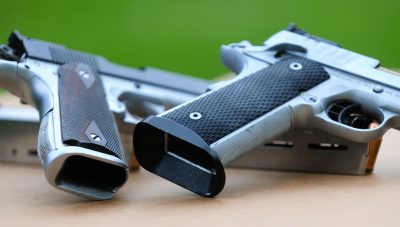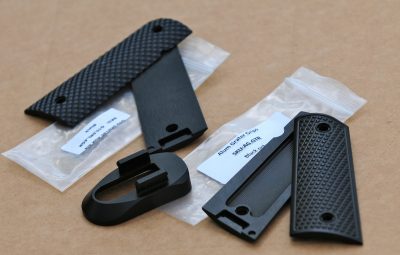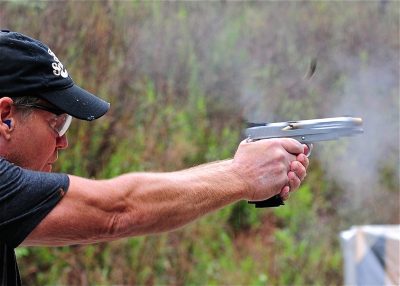
Although more “advanced” guns have dominated in competition in recent years, the tried-and-true single-stack 1911 is making a comeback today.
“Looks like you’ve come full circle,” that’s what an old friend of mine said when he saw me wearing a single stack .45 on my side at the Area 6 Championship in April. It was the truth, the 1911 .45 ACP pistol and I have come full circle in Practical Pistol shooting competitions. These matches are primarily held under the rules of the International Practical Shooting Confederation (IPSC) or United States Practical Shooting Association (USPSA). A .45 single stack is what I started competing with and I’m back shooting some USPSA/ IPSC major matches with one again. My friend had been around me and shooting long enough to recognize this wasn’t my high-capacity 3-Gun pistol!
In 1985, when I started shooting competitively almost everyone shot a 1911 .45 of one brand or another. These were the times before .40 S&W, before Glocks, before Para Ordnance, STI, or Infinity. There were no separate divisions for Open, Limited, Production, etc. It was heads up, run what you brung!
Major power factor was 175,000 (bullet weight X velocity) and if you weren’t making major you really weren’t in competition at all, so we all ran at or above 180,000 PF just to be sure. In those days, it was commonplace for even local matches to chronograph.
However, change is inevitable. First came compensators, built by the likes of the late Jim Clark Sr., originally designed for Bowling Pin Competitions and then specifically for Practical Shooting.
The next step in the 1911 evolutionary ladder was pushing the envelope of the .38 Super cartridge. Driving those smaller, lighter bullets at enough velocity to reach that magical Major power actor enabled you to score the most points possible for every scoring zone. The two round higher magazine capacity of the 1911 in .38 Super and higher pressures that made compensators more effective may not seem like much of an advantage, but it made all the difference in the world at a major match in those days.
Then the groundbreaking development of all the high-capacity pistols — new cartridges and dot sights — left the venerable Single Stack 1911 .45 in the safe gathering dust. Glock, Para Ordnance, Springfield P9, .38 Super, 9×21, STI, SVI, Caspian, .40 S&W, .38 Super Comp, all left little place in the world of practical pistol competition for the trusty 1911 .45 to compete in a heads up world.

With limited ammo on board, the single-stack 1911 requires some planning when it comes to reloading.
Back In Style
Along the way the sport grew, and all that has changed, too. USPSA was divided up into divisions so firearms could compete with similar guns and removed the gross disadvantages that limited magazine capacity had in the run-and-gun world of Practical Shooting sports. No longer did the old slab-sided .45 have to be kicked to the curb.
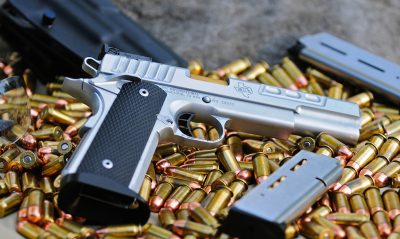
The author selected the excellent STI DVC Classic for use in the Classic/Single Stack Division competitions this year.
IPSC and USPSA both developed divisions for the esteemed 1911. The IPSC Classic Division and a very similar USPSA Single Stack Division were both designed for the old soldier of the sport — the Single Stack 1911! With rules allowing only steel-framed guns, eight-round magazine capacities (for Major and 10 round for Minor), maximum firearm weights, and limited modifications; these Divisions are meant for the drivers and lovers of the old .45 workhorse to have a place to compete and keep the legend alive.
The evolution and revolution of the 1911 are both alive and doing well. Modern machining and the lessons learned from 30 years of competition means even these classics can get the best triggers, sights, finishes and magazine wells available. These may be the Classic Division guns but they are leaps and bounds better than most of the 1911s of old.
Already, I have signed up for two major matches this year shooting the Classic/ Single Stack Divisions, and I’ll be looking for more as the year goes on. The USPSA Area 6 Championship held at South River Gun Club just south of Atlanta, Ga, was the first and I purchased a gun designed and released just for this purpose — the STI DVC Classic. A beautiful single stack .45 with most of the limited modifications that are allowed on a gun shooting in this division, all included straight from the factory.
As I said, the legendary classic is alive and well and has evolved a bit since its initial release and well beyond the modifications we thought were great in the 1980s. All the modifications that one would do over time to make a stock 1911 a better shooter are already done on this beauty — great sights, trigger, checkering, match barrel, mag well and the best part? You don’t have to wait for a gunsmith to get it all done. That wasn’t the case in the old days; the accessories were nowhere near as plentiful and the talent to have it done far less available.
The Next Step
The biggest challenge with going back to a single stack for competition is reloading those skinny magazines. Compared to reloading a double-stack, high-capacity gun with a mag well, the single-stack reload is a tough target. The Classic and Single Stack Division rules limit the size of the magazine well that can be added to the gun, but available options are certainly better now than in the past.
I decided to go with the Techwell IPSC XT, manufactured by TechWear. It is designed to give you all the mag well opening possible while staying within the rules of both organizations.
The Techwell magazine well is held on by their custom grips, and they offer a variety of grip choices depending on the shooter’s preferences. This magwell/ grip combination is an easy add-on requiring no gunsmithing or alterations to your gun! I chose the most aggressive-style grips to help me hang on to the gun under recoil. They also had a nice relief cut on the left panel, allowing better access to the magazine release. These aren’t the ones I would choose for everyday carry up against my skin, but they are optimal for a competition gun.
[one_half]
[/one_half]
[one_half_last]
[/one_half_last]
The Aluminum Grater and G10 DrillTec Aggressive model grips both feel as though they would enhance controlling your gun compared to a factory-style grip but would be better options for those not wanting quite as aggressive a set.
The use of any extended mag well usually requires you to use mags with extended base pads and that’s the case here as well. I tried a combination of manufacturers, Dawson Precision, Wilson, and Chip McCormick. The Dawson’s are purpose built for this and worked flawlessly without any modifications. I did have to do a little sanding to the others to ensure functionality with the magwell and to fit within the overall size requirements of the divisions (gun with empty magazine must fit within a box of specific size; see Rules at https://www.uspsa.org/ or https://www.ipsc.org/).
You can see there is quite a difference in the size of the available real estate between my old school .45 magwell and the STI with the Techwell. Reloading with the STI was so much easier and more reliable than finding my old magwell; which was state of the art circa 1990. That particular one was done by gunsmith Blake Gann. He did the work for many top shooters in the old days including multiple national/ world champion Todd Jarrett.
Fortunately, I found some time to get a little practice in the evenings after work and got acquainted with my new old friend. It felt natural in my hand, pointed where it was supposed to, and the front sight settled right back where it should be after the rise from the recoil.
So with a new gun, mags, holster, magazines extensions and about 400 rounds of freshly loaded Hornady 230-grain RN; I was ready to go reenter the world of 1911 Single Stack shooting I had left behind some 25+ years ago. Doesn’t seem near that long ago!

The author found the single-stack 1911 presented challenges and rewards with his time on the range with one.
On the Range
I was squadded to shoot the 12 stages of the match all in one day. As luck would have it, thunderstorms and rain were also forecast for most of that Sunday. Mother Nature didn’t disappoint and lived up to her side of the bargain; she let it pour a good part of the day. We had to take a few breaks for weather and target changes, but the show must go on, and it did! We shot under the clouds, in the drizzle, in the rain and were all soaked to the core a good part of the day.
The STI functioned flawlessly the entire match, mags fed reliably and I had zero equipment issues from my hurried but well-advised ensemble of equipment. In my haste on a couple of really fast-paced stages, I did fail to seat a magazine fully and that cost me a few seconds to actually seat it and continue shooting. The Techwell mag well and grips worked flawlessly and were not at fault; it was all me and the limited time spent with the new gear.

There were definitely a few new lessons to be learned coming back to this after so many years away. Many of the stages were set up so that you actually had eight shots or more from one position, and sometimes all on steel. This led to challenges due to the .45’s magazine capacity. At first I thought it would not be an issue, as most shooting Single Stack Division would face the same challenge, so there would be nothing given up.
As it turned out many shooting Single Stack were shooting Minor power factor 9mms and gaining the magazine capacity — 10 rounds rather than eight ….hmm! Would the higher capacity and lower recoil offset the loss in major power factor scoring, which would prove to be the winning combination?
Luckily, my old friend Gary Byerly was shooting his Single Stack 9mm on the squad with me. Gary is a very experienced shooter and has shot both USPSA and IPSC matches with his single stacks. This was going to allow me to do some analysis to see if the recoil management and magazine capacity of the 9mm was going to offset the scoring advantage of the major power factor .45.
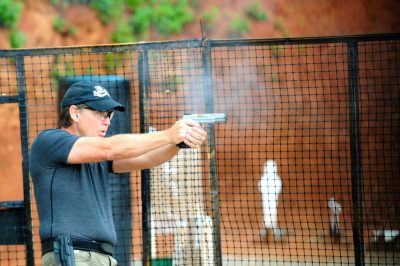
The competitive shooting range can be a great crucible for learning the strengths and weaknesses of selected guns and gear.
Speaking of Major power factor, the chronograph at the match confirmed what I had expected; my loads were a bit hotter than they needed to be and I could feel it in recoil and knew I was giving up some time in recoil control and accuracy at speed. I’ve found in the past that I could feel a change in control with as little as a 3,000 difference in power factor. As it turned out I was shooting slightly over a 177,000 pf with only a 165,000 required. You never want to risk being too low and falling under, so a 170,000 would have been plenty with a safety margin. In my rush to prepare, I hadn’t groomed my loads quite as well as I should have and I was paying the price with every shot now! Noted, not to happen again.
We shot a variety of short fast speed stages, a shoot house-styled stage, several field courses and one standards course. The standard course involved shooting freestyle, strong hand only and support hand only. This proved to be the stage I did the best on in the match; a testimony to the control of the .45 with the gun/ grip combination I had chosen.
After a long day in the clouds/ rain and quite a few stages of having fewer options to choose from due to magazine capacity, I think the 9mm Single Stack may have been the way to go for this match! The majority of the targets in this match had been wide open targets. There were very few No Shoots, and not much Hard Cover limiting the scoring zones on the targets. I think this allowed Minor power factor guns to shoot at a closer level to the Major guns.
I have shot a Minor gun before in a large match and decided at the time that it wasn’t the right choice. However, at that match, over half the targets either had hard cover or No Shoots covering a significant part of the scoring zones and forced you to take more outside shots. This reduced your opportunity for hitting the higher scoring areas of the targets and made a big difference in the match results. This is going to vary from match to match, so making the right decisions are difficult due to the variances of match design in Practical Pistol shooting.
The overall results from the match prove just as inconclusive. The Single Stack Division winner shot a Major power factor gun with a magazine capacity of eight rounds. He was one of only four out of the top 10 to do so, yours truly being another of those. Expanding on that; only six of the top sixteen shot Major guns, all the rest choose to shoot Minor power factor guns. Regardless of whether the gun is Major, Minor, .45 ACP, 40 cal, 9mm, eight rounds, 10 rounds, the old single stack was great fun to get out and shoot. It fits your hand, fills a place in history and certainly still has its place in the competition world.
The single-stack 1911 has always had a place in the International Defensive Pistol Association (IDPA) and Bianchi Cup competitions. With its own division in IDPA, it has always had a standing crowd of supporters. Over on the slightly different competition circuit there are a few years of the revolver winning the Bianchi Cup, but the 1911 has dominated it for most of its years since its founding in 1979.
You can also see how the 1911 has flourished and grown by looking at how many manufacturers are out there now with single stack offerings: Springfield Armory, STI, Kimber, Nighhawk, Wilson, DoubleStar, Sig, Dan Wesson, Taurus, Rock Island, Smith & Wesson, Colt and many more. There are even more small shops and gunsmiths out there that make their daily bread and butter from the custom work and upgrading of 1911s. In addition, there are folks like World Champion shooter Bruce Piatt, who holds classes teaching students how to hand fit and build their own custom single stack guns.
Yep, I’ve come full circle, one 25 year revolution in time, learning and evolving as well. I’m back to shooting a Single Stack 1911 and I like it!
For more information, visit https://www.uspsa.org/.
To learn more about the STI DVC Classic pistol, visit https://stiguns.com/guns/dvc-classic/.
To purchase an STI pistol on GunsAmerica.com, click this link: https://www.gunsamerica.com/Search.aspx?Keyword=STI.

